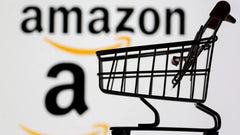
Amazon Prime Day 2025: Sales Plunge by 41% on Day One Amid Consumer Caution and Tariff Fears
Table of Contents
- Key Highlights:
- Introduction
- Discount Delays and Bargain Hunting Define Day One
- Competitive Retail Environment Fuels Online Sales Surge
- Tariffs and Consumer Caution Cloud Prime Day’s Future
- The Psychological Impact of Extended Sales Events
- The Future of E-Commerce and Retail Strategies
- The Role of Social Media and Influencers
- The Importance of Data-Driven Decision Making
- FAQ
Key Highlights:
- Amazon's Day 1 sales for Prime Day 2025 fell by 41% compared to the previous year, according to Momentum Commerce.
- Shoppers adopted a "wait-and-see" approach, focusing on essentials, with nearly two-thirds of purchases under $20.
- Competing retailers like Walmart and Target benefited from the situation, contributing to a 9.9% increase in overall online sales.
Introduction
The annual Amazon Prime Day has become a staple in the calendar for many consumers and retailers alike, often heralded as an opportunity for steep discounts and significant sales boosts. However, the 2025 iteration of this event has revealed deep-seated challenges as Day One sales plummeted by 41% compared to last year's opening day. Factors such as consumer caution, an extended four-day format, and uncertainty surrounding tariffs have reshaped shopper behavior, leading many to adopt a more strategic approach to their purchases. As the event unfolds, the implications for Amazon and the broader retail landscape are significant, influencing everything from stock market performance to online shopping trends.
Discount Delays and Bargain Hunting Define Day One
On the first day of Prime Day 2025, shoppers flocked to Amazon, yet their purchasing behavior reflected a marked shift in strategy. Rather than impulsively buying high-ticket items, many consumers filled their carts with lower-cost essentials and delayed finalizing their purchases. According to Momentum Commerce, nearly two-thirds of all transactions were for items priced under $20. This shift highlights a growing trend among consumers to prioritize everyday necessities over luxury or discretionary items.
Popular purchases included basic household products like Dawn dish soap, Premier protein shakes, and Finish dishwasher aids. The average price for items sold during this period dropped to $25.46, down from $28 in the previous year. This decline signifies a broader consumer focus on practical items rather than big-ticket electronics, which typically characterize the event.
Momentum Commerce CEO John Shea noted that the four-day format of Prime Day may have contributed to a diminished sense of urgency among shoppers. With the fear of missing out (FOMO) largely eliminated, consumers appeared more inclined to engage in what Shea referred to as "treasure hunting," taking their time to seek out the best deals.
Competitive Retail Environment Fuels Online Sales Surge
Despite Amazon's struggles on Day One, the overall landscape of online shopping showed remarkable resilience. Total US online sales surged by 9.9%, reaching $7.9 billion as competitors such as Walmart, Target, and Wayfair aggressively promoted their own sales events. Adobe Analytics predicts that the four-day sales period could generate up to $23.8 billion across all retailers, a promising figure that highlights the competitive nature of the online retail sector.
The phenomenon referred to as the "halo effect" was also evident, with increased consumer interest in Prime Day driving traffic to non-Amazon sites. Direct-to-consumer brands reported stronger growth during this period, benefiting from the heightened awareness and excitement surrounding Amazon's event.
Amazon's Vice President for Prime, Jamil Ghani, defended the extended format, asserting that consumers expressed a desire for more time to shop. He pointed out growth in everyday categories, such as teeth-whitening strips, which align closely with the trend of consumers prioritizing essential items.
Tariffs and Consumer Caution Cloud Prime Day’s Future
As the Prime Day event unfolded, the specter of trade policy uncertainty loomed large. The potential for renewed tariffs on Chinese imports has prompted many brands to adjust their pricing strategies, resulting in smaller average discounts of 21%, compared to 24% in 2024. This cautious approach may have further dampened consumer enthusiasm, as shoppers became wary of the financial implications of their purchases.
The 2025 Prime Day represented a notable shift in strategy for Amazon, attempting to position itself as a "mid-year Black Friday." However, this pivot came at a time of declining consumer confidence, leading many to view the event primarily as an opportunity for pantry stocking rather than an occasion for splurging on luxury items.
The outcomes of Days 3 and 4 will be pivotal in determining the overall success of this year's Prime Day. Momentum Commerce remains cautiously optimistic, projecting a potential 9.1% increase in overall sales if last-minute deals manage to spur pent-up consumer demand.
The Psychological Impact of Extended Sales Events
The shift to a four-day Prime Day format reflects an evolving understanding of consumer psychology in the realm of e-commerce. Traditionally, limited-time sales events create urgency, driving consumers to make quick purchasing decisions. However, as evidenced by this year's performance, extending the event duration may have inadvertently led to a more deliberate approach among shoppers.
By eliminating the immediate urgency typically associated with flash sales, Amazon may have inadvertently encouraged consumers to take their time, leading to decreased sales on Day One. This behavioral change suggests that consumers are becoming more discerning about their spending habits, influenced by economic factors and a growing awareness of the importance of budgeting.
The Future of E-Commerce and Retail Strategies
The implications of Prime Day 2025 extend beyond Amazon's sales figures; they reflect broader trends within the e-commerce landscape. As consumer preferences shift towards essentials and prudent spending, retailers must adapt their strategies to meet these changing demands.
In the wake of this year's Prime Day, brands may need to reassess their promotional strategies, focusing on value propositions that resonate with cost-conscious consumers. The success of competitors like Walmart and Target during this period underscores the need for retailers to cultivate loyalty and trust among shoppers, ensuring they remain competitive in an increasingly crowded marketplace.
The Role of Social Media and Influencers
Social media has become a powerful tool for driving consumer engagement and influencing shopping behavior. As Prime Day approached, retailers leveraged platforms like Instagram and TikTok to promote their sales events, utilizing influencers to generate buzz and excitement.
The effectiveness of these strategies in shaping consumer perceptions and encouraging purchases cannot be understated. As seen in the outcomes of Prime Day 2025, brands that successfully engage consumers through social media may experience enhanced visibility and sales, capitalizing on the interconnected nature of digital marketing.
The Importance of Data-Driven Decision Making
In an era where consumer behavior is rapidly changing, leveraging data analytics is essential for retailers seeking to navigate the complexities of e-commerce. Retailers can utilize insights gathered from previous sales events to inform their strategies, tailoring promotions and inventory to align with shifting consumer preferences.
The ability to analyze consumer purchasing patterns in real-time allows brands to respond agilely to market demands, optimizing their offerings to maximize sales potential. As the retail landscape continues to evolve, data-driven decision-making will remain a crucial component of successful e-commerce strategies.
FAQ
What caused the sales decline on Amazon Prime Day 2025?
The significant 41% drop in sales was attributed to a "wait-and-see" approach by consumers, focusing on essentials and smaller purchases rather than high-ticket items.
How did competitors perform during Prime Day?
While Amazon struggled, total US online sales increased by 9.9%, with retailers like Walmart and Target benefiting from the heightened shopping activity.
Are tariffs affecting consumer behavior?
Yes, uncertainties surrounding potential tariffs on imports led brands to offer smaller discounts, influencing consumer purchasing decisions and contributing to a more cautious shopping environment.
What does the future hold for Amazon Prime Day?
The event's success will hinge on the performance of the remaining days, with potential for a rebound if consumers respond to final deals. The evolving nature of consumer preferences will also play a significant role in shaping future Prime Day strategies.
How can retailers adapt to changing consumer behavior?
Retailers should focus on data-driven decision-making, leveraging insights into consumer behavior to tailor their offerings and promotions. Engaging consumers through social media and emphasizing value propositions will also be vital in maintaining competitiveness.
Vylepšete svůj e-commerce s našimi týdenními poznatky a aktualizacemi!
Zůstaňte v souladu s tím, co se děje ve světě obchodu
E-mailová adresa
Vybráno pro Vás
10 July 2025 / Blog
Shopify's Strategic Acquisition: Navigating the Future of E-Commerce with AI
Přečtěte si více
10 July 2025 / Blog
Amazon Now Expands 10-Minute Delivery Service in India: A Game-Changer in Quick Commerce
Přečtěte si více
10 July 2025 / Blog


